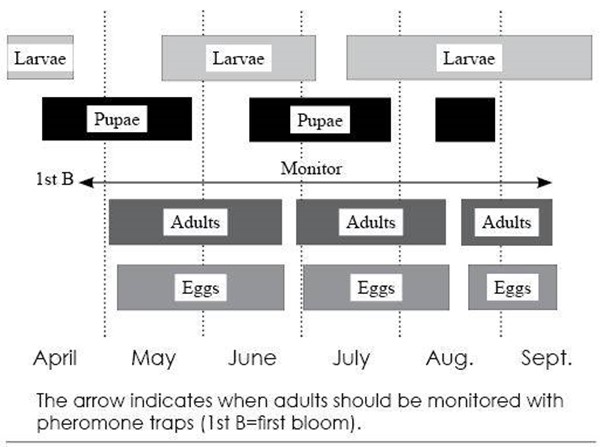Codling moth (Cydia pomonella; Order Lepidoptera, Family Tortricidae) is the most serious pest of apple and pear worldwide, rarely apricots, peaches, plums and quince. In most of Northern Nevada, fruit must be protected all season up to harvest for a quality crop. Insecticides are the main control method, with both organic and conventional options available.
- Codling moth is the major pest of apple and pear, where the larvae tunnel into fruit.
- Codling moths have 2 to 3 generations in Nevada, and therefore, fruit is susceptible to attack all season long.
- This pest is monitored by inspecting fruit for damage and with pheromone traps.
- Cultural controls include sanitation, trunk banding, and fruit thinning.
- Biological controls, if used smartly, are effective and safe.
- Chemical controls are effective but likely to also kill beneficial insects.
Codling Moth Control
In spring, moths start emerging from the larva which over wintered in the ground when high temperatures exceed 55°F and the low temperature are above 40 °F. After the initial hatching, mating occurs and eggs are deposited on developing fruit and on leaves close to the fruit. A female moths can each lay 30 to 70 eggs. Larva emerge from the egg which is on the fruit and burrows into the fruit, which is the start of the damage. Often immature fruit with larval damage will drop, but do not confuse this with the normal thinning fruit drop. The larva develops into a pupa which will later emerge as an adult moth.
Moana Nursery recommends using pheromone traps to monitor the hatching of the coddling moths in your particular micro-climate. These trap should be set out at the end of the flowering period for your apple. One in your yard, near or in a apple tree, but easy to observe, is recommended. In the non- hatching period, one or two moths will be trapped per 24 to 48 hour period. A hatching is generally indicated with seven or more moths trapped per day upon your inspection. When the trap indicates a hatching is taking place, treatment of the tree and its fruit should follow immediately. Extreme care should be taken not to apply any pesticide, organic or non-organic, while the pollinators are out.
For Organic Control – spray the tree with Spinosad, or an oil and again ten days later. Most organic formulations typically have short re-entry wait periods and wait times for harvest periods, so be sure to follow the label carefully.
For Non-Organic Control – spray the tree with Permethrin, or Carbaryl. With these options, there are longer wait periods that must be followed before re-entry into the area and also before harvesting. These are noted by the number of days of the insecticide’s label.
For both methods, organic or non-organic, after the second spraying, wait two weeks and then put out another trap to monitor for the second hatching. The entire process of monitoring and spraying then repeats, and again for the third hatching.
Adapted for Nevada from Utah State University Extension: winter until customers ask me what can be done https://extension.usu.edu/pests/research/codling-moth-in-Utah-Orchards
Hatchings
In our Northern Nevada Intermountain Region, there are typically three hatchings in a year, which in turn tell when control measures should be applied.

